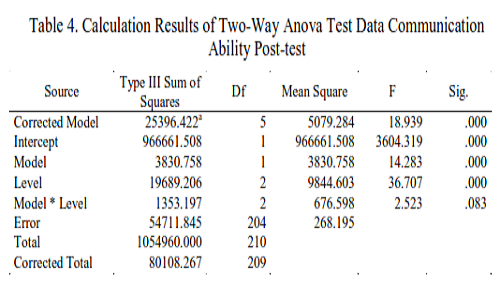
The Effect of the Application of the 5E Learning Cycle Model on Mathematical Communication Skills in Junior High School Students
Abstract
This research is motivated by the low students mathematical communication skills. To overcome this problem is by improving the learning process that provides opportunities for students. One of them is by applying the 5E Learning Cycle model. The 5E Learning Cycle model is a series of activities so that students can master the competencies achieved in learning by taking an active role, directed to seek and discover new knowledge themselves. The research is to investigate the impact of the application of Learning Cycle 5E on mathematical communication skills in terms of overall, ability level and, interaction between learning model and ability level. This research is a quasi-experimental study with a pretest post-test control design. The results of data analysis show that the mathematical communication skills of students who learn using the 5E learning cycle model are better than students with conventional learning. For students mathematical communication skills at the moderate level, the 5E learning cycle model is better, but not better for high and low levels. There is no interaction between the learning model and ability level of mathematical communication skills.
Keywords
Full Text:
PDFReferences
Asikin, M. (2013). Kemampuan Komunikasi Matematika Siswa SMP dalam Setting Pembelajaran RME (Realistic Mathematics Education). Unnes Journal of Mathematics Education Research, 2(1), 203-213.
Asmawati, & Wuryanto. (2014). Keefektifan Model Pembelajaran LC 5E dan TSTS Berbantuan LKPD Terhadap Hasil Belajar. Jurnal Kreano, 5(1), 26-32.
Jurnaidi, & Zulkardi. (2013). Pengembangan Soal Model Pisa Pada Konten Change and Relationship untuk Mengetahui Kemampuan Penalaran Matematis Siswa Sekolah Menengah Pertama. Jurnal Pendidikan Matematika, 7(2), 37-54.
Lely, & Arie, M. (2016). Pengaruh Model Pembelajaran Learning Cycle terhadap Kemampuan Komunikasi Matematis Siswa dengan Belief Matematika. Seminar Nasional Matematika dan Pendidikan Matematika UNY.
Marlina, Ikhsan, M., & Yusrizal. (2014). Peningkatan Kemampuan Komunikasi dan Self-Efficacy Siswa SMP dengan Menggunakan Pendekatan Diskursif. Jurnal Didaktik Matematika, 1(1), 35-45.
Hutapea, N. M. (2013). Peningkatan Kemampuan Penalaran, Komunikasi Matematis, dan Kemandirian Belajar Siswa SMA Melalui Pembelajaran Generatif. Lembaga Pascasarjana UPI.
Agustyaningrum, N. (2011). Implementasi Model Pembelajaran Learning Cycle 5E untuk Meningkatkan Kemampuan Komunikasi Matematis Siswa Kelas IX B SMP Negeri 2 Sleman. Seminar Nasional Matematika dan Pendidikan Matematika.
Deswita, R. (2015). Penerapan Model Pembelajaran Connecting-Oranizing-Reflecting-Extending (CORE) dengan Pendekatan Scientifict untuk Meningkatkan Kemampuan Komunikasi dan Koneksi Matematis serta Self-Efficacy Siswa SMP. Tesis tidak diterbitkan, Lembaga Universitas Pendidikan Indonesia, Bandung.
Astuti, S. Z., & Nurita, T. (2018). Penerapan Lembar Kerja Siswa untuk Melatihkan Keterampilan Proses Sains Siswa. E-Journal Pensa. 6 (2), 204-207.
Sugiyono. (2013). Metode Penelitian Pendidikan pendekatan Kuantitatif, kualitatif, dan R & D. Alfabeta: Bandung.
Sumarmo, U. (2017a). Hard Skills dan Soft Skills Matematik Siswa, PT Refika Aditama: Bandung.
Sumarmo, U. (2017b) Penilaian Pembelajaran Matematika, PT Refika Aditama: Bandung.
Umar, W. (2012). Membangun Kemampuan Komunikasi Matematis dalam Pembelajaran Matematika. Jurnal Infinity,1(1), 1-9.
DOI: http://dx.doi.org/10.31258/jes.5.2.p.257-266
Refbacks
- There are currently no refbacks.
Copyright (c) 2021 Putri Aulia Susanti

This work is licensed under a Creative Commons Attribution 4.0 International License.
Publisher: FKIP Universitas Riau












